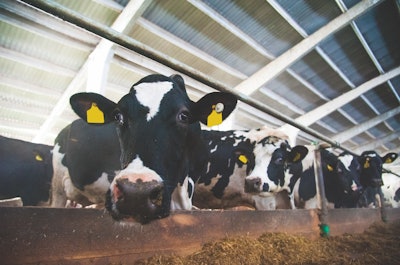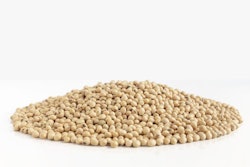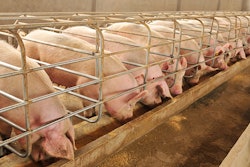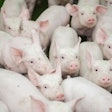
Iowa State University ruminant nutritionist Lance Baumgard discusses why we need to think differently about the transition period in a dairy cow’s life.
Ann Reus: Hello and welcome to the Feed Strategy podcast. I’m your host, Ann Reus, and I’m live here at the American Feed Industry Association’s Liquid Feed Symposium in Oak Brook, Illinois. I’m speaking today with Iowa State University ruminant nutritionist Lance Baumgard, one of the presenters at the symposium.
Hi, Lance.
Lance Baumgard: Hi Ann.
Reus: Tell me a little bit about the topic of your talk at Liquid Feed Symposium.
Baumgard: Well, my group has been re-evaluating some traditional dogmas of a transition period in dairy cows, specifically that high NEFAs, or non-esterified fatty acids, and the resulting ketones are somehow dangerous for cow health. And, in addition to those two, we’ve been evaluating hypercalcemia. And these are all three changes in metabolites that are occurring in the transition period. And we’ve connected them over the last 50 years with negative outcomes like health, poor reproduction, poor milk yield, etc. And so we’ve been leery of that dogma for a long time, but now finally have enough information, I think, to challenge it and suggest that it’s actually not causing problems, it’s correlated with problems. So that’s what our talk’s about today.
Reus: OK, great. What makes a dairy cow’s transition period unique when it comes to their nutrition and health?
Baumgard: Well, the timeframe of the transition period is the window of time when culling, or them experiencing a negative outcome is the is the highest, the likelihood is the highest. So, a lot of economically important issues occur during this timeframe. And the likelihood of her having a profitable lactation, a whole lactation, in large part depends upon how well she can navigate through this window of time without having a negative outcome. So, and then, of course, the nutrient demand of lactation is immense, especially compared to gestation. And of course, this has been augmented with the last 200 to 300 years of genetic selection for milk yield. So it’s a critical time, I don’t I don’t want to use the word stressful because I don’t think having babies is stressful – I mean, yeah, having babies is stressful, but every female animal on the planet does it. It’s a component of reproduction. And I think we should view it as, OK, this is normal biology, how do we help her get through it without complications.
Reus: Kind of nurture the nature.
Baumgard: Exactly.
Reus: How can feeding and nutrition strategies be used to help overcome some of the challenges during the transition period?
Baumgard: So, our hypothesis is that immune activation during the transition period is, in large part, causing these fluctuations, these changes in some of these non-esterified fatty acids, ketones, etc. So, it sounds obvious, but we want to minimize immune activation. Well, a large part that is management, right, making sure that the calving pen is clean, try to minimize the opportunity for the mammary gland to pick up a pathogen between dry off and calving. But nutrition, we think, plays a big role in this immune activation as well, in that immune activation is likely stemming from post-rumen issues. It could be rumen pH or rumen acidosis, but then, we also think it’s large intestine or maybe even small intestine acidosis. So, nutrition has a big impact there on keeping fermentation and digestion up in the rumen, not allowing soluble nutrients to escape the rumen and get into the large intestine. So that’s ration balancing. Well, actually, that goes all the way back to harvesting corn silage, right? Kernel processing, the whole ball of wax, synchronization of protein and carbohydrate for mutations, etc. In addition, though, I firmly believe that nutrition can have a huge role on improving the strength of the barrier function of the both the rumen and the large intestine, and the small intestine probably. So my group has been looking at a variety different strategies to do that. We looked at zinc in a variety of different ways, in beef cattle, in dairy cattle and pigs. Almost every time we’ve used zinc, it does a nice job of improving barrier function. There’s other strategies to improve barrier function of the epithelium. I’ll go through some of those maybe in the talk, but I think nutrition and nutritionists have a huge impact on the likelihood that the cow is going to get through the transition period of experiencing some type of negative consequence.
Reus: Can you detail a little bit more some of your latest research in this area and what you hope to achieve with your studies?
Baumgard: I guess ultimately, we’re hoping to have a better understanding of these changes that occur in calcium, non-esterified fatty acids, ketones and glucose, etc. And, in high-producing dairy cows, you’re going to have huge fluctuations in these metabolites that’s natural, it’s normal. A huge change in non-esterified fatty acids and ketones and a decrease in calcium is normal, and nothing that we should be overly afraid of, as long as she’s eating well, and milking well. In my opinion, the two best metrics of animal health is their appetite and their productivity. If they’re sick, they’re not going to eat, they’re not going to milk. So, as long as they’re milking well and eating well, well then these other changes that we’re measuring, we’re worried about, really aren’t problems, they’re just reflective of high productivity. Alternatively, if the animal gets sick, metritis, mastitis, leaky gut, pneumonia, it doesn’t matter, they’re going to go off feed. And this lack of appetite, then, is also going to cause high levels of NEFA, high levels of ketones and, incidentally, also causes a decrease in calcium. So, this metabolic profile that we’ve been concerned about for a long time, you have you have two cows that fit into this category: One that’s making a lot of milk and she’s the healthiest cow in the transition pen and she’s doing exactly what Mother Nature wanted her to do and make a lot of milk. And these adjustments and non-esterified fatty acids and ketones and calcium reflect what she needs to enlist to make milk. OK, that’s the healthy cow. But then you have this other cow that has, you know, either some clinical or subclinical mastitis, metritis, or pneumonia or whatever. leaky gut, it also now has high NEFAs, ketones and low calcium, so that the metabolic profile is almost identical, but one cow’s a rock star and profitable, the other cow’s a dog, right? So, hence this confusion we’ve had for such a very long time, and we need to then figure out OK, how do we identify the cow that’s essentially sick versus the rock star and that’s really pretty easy to do just if you can get some estimate of feed intake and milk. If she’s milking like a rock star, leave her alone, right? If she’s crashing and burning with feed intake and milk, again, you’ve got to identify where is the infection. Where’s the immune activation occurring, and fix that. The high NEFAs and the high ketones are a reflection of her for lack of appetite, fixing the hyperketo anemia in the sick cow is not going to fix the problem. That’s not the issue, it’s a reflection of the problem. So that’s a long-winded answer, Ann, and that’s what I’ll be talking about today. And that’s what my group’s been working on for the last five or six years.
Reus: So, it sounds like it comes down to the trend of precision nutrition and individualized feeding and monitoring the individual animal as opposed to the herd.
Baumgard: Exactly, so we had this new precision agriculture which can be helpful, but also let’s not forget Husbandry 101, right? Can the cowboy or the can the farmer identify, OK, that cow’s not looking good. It just doesn’t look good, the ears are droopy, it’s not aggressively coming to the bunk. Its rumen is not filled out. And, of course, if you have daily milk weights, you can track how they’re doing, right? So yeah, a combination of precision agriculture with some old-fashioned, common-sense cow-side knowledge.


















